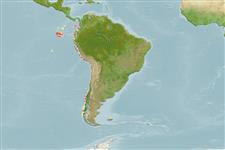Elasmobranchii (haaien en roggen) (sharks and rays) >
Rajiformes (Skates and rays) >
Rajidae (Skates)
Etymology: Rajella: Latin, raja, -ae = a sting ray (Raja sp.) (Ref. 45335); eisenhardti: Named after E. Roy Eisenhardt..
More on authors: Long & McCosker.
Environment: milieu / climate zone / depth range / distribution range
Ecologie
marien bathydemersaal; diepte 757 - 907 m (Ref. 31078). Deep-water
Southeast Pacific: Galapagos Islands. Not in Compagno's 1999 checklist (Ref. 35766).
Grootte / Gewicht / Leeftijd
Maturity: Lm ? range ? - ? cm
Max length : 38.5 cm TL mannelijk / geslacht onbekend; (Ref. 31078)
Oviparous (Ref. 50449). Eggs have horn-like projections on the shell (Ref. 205).
Levenscyclus en paargedrag
Maturities | Voortplanting | Spawnings | Egg(s) | Fecundities | Larven
Oviparous, paired eggs are laid. Embryos feed solely on yolk (Ref. 50449).
Long, D.J. and J.E. McCosker, 1999. A new species of deep-water skate, Rajella eisenhardti (Chondrichthyes: Rajidae) from the Galápagos Islands. Proc. Biol. Soc. Wash. 112(1):45-51. (Ref. 31078)
Status op de Rode Lijst van het IUCN (Ref. 130435)
Gevaar voor de mens
Harmless
Gebruik door de mens
Tools
Speciale rapporten
Download XML
Internetbronnen
Estimates based on models
Preferred temperature (Ref.
123201): 4.5 - 5.8, mean 5.7 °C (based on 3 cells).
Fylogenetische diversiteitsindex (Ref.
82804): PD
50 = 0.5000 [Uniqueness, from 0.5 = low to 2.0 = high].
Bayesian length-weight: a=0.00302 (0.00141 - 0.00645), b=3.24 (3.07 - 3.41), in cm total length, based on LWR estimates for this (Sub)family-body shape (Ref.
93245).
Trofisch niveau (Ref.
69278): 3.6 ±0.5 se; based on size and trophs of closest relatives
Weerstandsvermogen (Ref.
120179): laag, minimale populatieverdubbelingstijd 4,5-14 jaar (Fec assumed to be <100).
Fishing Vulnerability (Ref.
59153): Low to moderate vulnerability (28 of 100).
